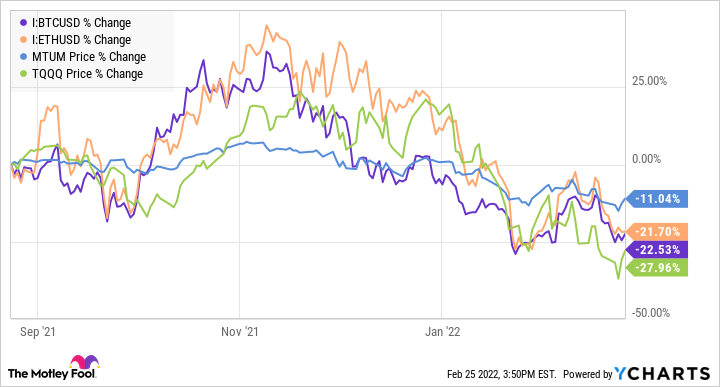If cryptocurrencies are part of your investment portfolio, it's important to really understand how they're behaving in today's capital markets. The narrative about Bitcoin (BTC -3.19%) and Ethereum (ETH -1.75%) in popular media and some message boards has been a bit misleading if we look at the data. Make sure that you're using crypto assets the right way to avoid unwanted outcomes.
Assets working in harmony
Different assets play different roles in an investment portfolio. Growth stocks have great long-term potential returns, but they are volatile. Value stocks can provide decent upside, but they generally carry lower risk and reward. Dividend stocks provide regular investment income, regardless of market conditions. Bonds generate interest income, and they're typically lower volatility than equities. None of these are better or worse than the other, but they fulfill specific niches, and they're valuable in various ways to different investors.
Crypto assets need to be understood in this same context -- they have some really attractive features, but they're not universally suitable for all functions. If we understand how and why cryptocurrencies perform the way they do, we can figure out how to deploy them responsibly in a portfolio.

Image source: Getty Images.
Performance and correlation
Crypto investors are well aware of the repeated boom and bust cycles that have characterized the market in recent years. The forces driving these cycles are fairly complex, and plenty of people have weighed in with market analysis and forecasts. It's anyone's guess where Bitcoin and its peers will go in the future, but there are some undeniable trends taking shape.
Bitcoin and Ethereum have been highly correlated to the iShares MSCI Momentum Factor ETF so far in 2022. This year has been characterized by a steep sell-off in the stock market, especially among high-valuation growth stocks. Rising interest rates, lukewarm economic outlook, and geopolitical turmoil are all playing a role in this market correction.
It makes sense that cryptos and higher-risk stocks move in generally the same direction, but the day-to-day fluctuations are striking. They are moving up and down in unison, but cryptocurrencies are even more volatile than the stocks. It's clear that the same forces are guiding both markets so far this year.
Bitcoin, Ethereum, MTUM Price data by YCharts.
This trend isn't isolated to the past two months. Over six months, Ethereum and Bitcoin both have similar price charts to the ProShares UltraPro QQQ ETF, which is a leveraged ETF that is meant to multiply the NASDAQ's performance by three times. These assets are still correlated with the overall momentum trade, but, again, far more volatile.
Bitcoin, Ethereum, MTUM, TQQQ Price data by YCharts.
A similar trend is still obvious going back a full year. Obviously, the catalysts for each market aren't identical, but they clearly have common influences. Following the 2020 market recovery, speculators and exuberant investors bid several asset classes to historically high valuations, and that momentum has been unravelling in recent months.
Bitcoin, Ethereum, TQQQ Price data by YCharts.
Notably, Bitcoin's chart has looked absolutely nothing like the gold spot price over the past six months. A core part of Bitcoin's philosophy is to function as an alternative and a hedge to fiat currency. Many early proponents and adopters heralded cryptocurrencies as "digital gold" with attractive deflationary features. We're experiencing historically high inflation rates, caused in part by central bank responses to the COVID-19 economic crisis. Over this exact time frame, Bitcoin has behaved more like a speculative growth stock and less like a stable store of value.
Bitcoin, Gold Price data by YCharts.
Crypto in your portfolio
None of this is an indictment of cryptocurrency, but it's essential context. Over the past few years, there's been a clear shift in the motivation of cryptocurrency traders and investors. The market is being dominated by short-term speculators at the moment.
For the time being, investors need to treat cryptocurrency assets as if they are highly volatile growth stocks. Over the long term, it's still fair to think that the value of crypto assets will reflect fundamentals. Widespread adoption of certain technologies could lead to substantial appreciation of digital tokens and coins. However, the prices of today's most popular crypto assets aren't based on utility and fundamentals. Instead, they're based on short-term supply and demand trends as people continue to figure out these assets and their markets. When investors panic a bit, there aren't any meaningful fundamentals to serve as a backstop, and prices can tank drastically.
That's not necessarily a reason to avoid crytos. Many of the best- performing assets require a leap of faith and tolerance for extreme volatility. However, investors should ensure that they can handle that volatility. It might not be wise to own these assets if you have a short time horizon or you can't stomach the steep drops. If you want to use Bitcoin as "digital gold" to protect against the current inflation crisis, there are less-volatile assets that are probably more suitable for this purpose. Don't make the mistake of thinking cryptos offer meaningful diversification to ultra-high growth stocks, because they're moving closely together right now. Instead, consider them as a candidate to fill the high-risk, high-reward role of your overall investment plan.









